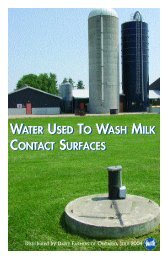Canadian Quality Milk On-Farm Food Safety Program - Centre ...
Canadian Quality Milk On-Farm Food Safety Program - Centre ...
Canadian Quality Milk On-Farm Food Safety Program - Centre ...
You also want an ePaper? Increase the reach of your titles
YUMPU automatically turns print PDFs into web optimized ePapers that Google loves.
<strong>Canadian</strong> <strong>Quality</strong> <strong>Milk</strong><br />
If a bulk tank is washed manually, ensure that it is clean. The same cleaning<br />
principles apply to both manually and automatically washed systems. Producers who<br />
manually wash bulk tanks should follow these recommended four steps:<br />
• Step 1: Rinse the bulk tank and the bulk tank valve to remove residual milk<br />
(e.g. with hose), as soon as possible after milk is picked-up. <strong>Milk</strong> should not<br />
be allowed to dry on any parts of the bulk tank.<br />
• Step 2: Warm the bulk tank before the hot wash, by rinsing it with warm<br />
water. Steps 1 and 2 can be accomplished by adding a "Y" hose to your hot<br />
and cold taps and turning them both on, so that the warm first rinse also<br />
warms up the bulk tank.<br />
• Step 3: Wash the bulk tank and bulk tank valve with hot water (e.g. 71°C<br />
(160°F) or according to the Cleaning and Sanitizing Chart) and soap. Put the<br />
hot water and soap in a clean 1-2 gallon plastic bucket, set the bucket inside<br />
the bulk tank, and brush wash the bulk tank from the bucket. The water will<br />
remain hot throughout the whole wash and your soap concentration will be<br />
high. Never add soap and water directly to the tank. Rinse the soap and water<br />
out of the bulk tank. A clean plastic bucket will not scratch your bulk tank’s<br />
polished finish.<br />
• Step 4: Add warm or cold water and acid to your bucket and lightly brush the<br />
bulk tank. Let it drain. Do not rinse.<br />
Note: If the bulk tank was washed several hours before the first milking, it is<br />
recommended to sanitize the tank about 20 minutes before the first milking.<br />
Add warm or cold water and sanitizer to your clean wash bucket and lightly<br />
brush the bulk tank milk contact surfaces.<br />
Sanitize the surfaces regularly to minimize bacteria level on equipment surfaces.<br />
Wash your hands to reduce bacteria level on hands.<br />
Check the milk temperature or inspect the empty bulk tank, specifically the<br />
interior, paddle, dipstick and outlet valve for cleanliness once a week using a strong<br />
flashlight. Record what you see.<br />
Check that the bulk tank is completely drained. This will ensure water is not<br />
being added accidentally to the milk and affecting the freezing point, and ensure<br />
cleaning/sanitizing chemicals are not being added to the milk. If the milk contact<br />
surface is unclean, refer to Chapter 11 for troubleshooting guides.<br />
Close the bulk tank outlet valve and put on end cap. Avoid contact with the rim<br />
or inside of the valve and cap with your fingers, as this will contaminate the inside<br />
milk contact surfaces.<br />
Check the milking units for cleanliness and the teat cup liners for proper<br />
alignment. This will ensure raw milk is not being contaminated with residual<br />
bacteria, and that liners are working properly. If any of the milk contact surfaces are<br />
unclean, refer to Chapter 11 for troubleshooting guides.<br />
5—4<br />
June 2010
















